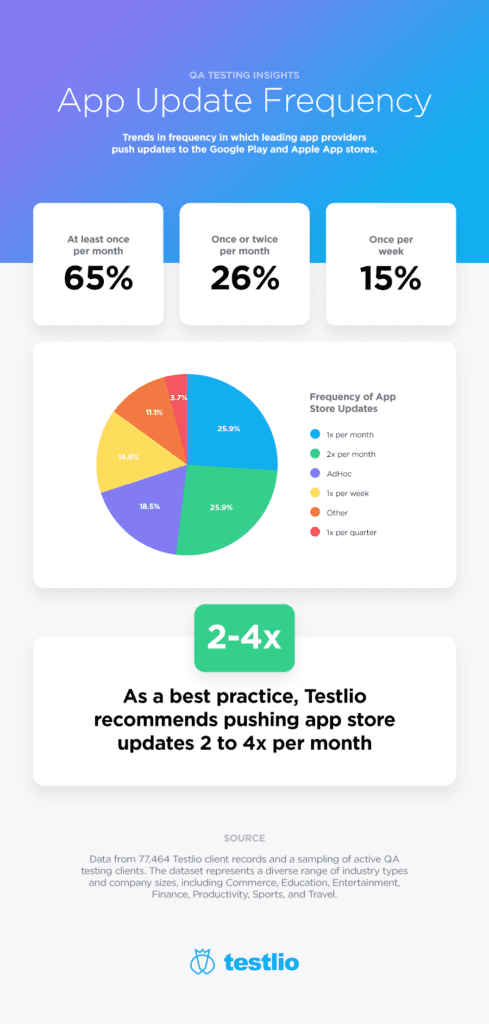How Often Should You Update Your Mobile App?
The author recommends that most mobile app providers release every one or two weeks — read on to see the research!
Join the DZone community and get the full member experience.
Join For Free
For Android, iOS, and other apps, release frequencies vary. Managed app testing leader Testlio recently queried more than 75K client release records, covering a diverse range of industries (including Commerce, Education, Entertainment, Finance, Productivity, Sports, and Travel). Collectively, these Testlio clients have a user base of more than 1.5 billion people.

Based on a comprehensive analysis, client conversations and other considerations, Testlio recommends that most mobile app providers release every one or two weeks. Specific Testlio's findings on their clients' mobile app release frequencies are:
- 65% of providers release at least once per month.
- 26% of providers release every two weeks.
- 15% of providers release every week.
The Testlio findings are consistent with other research and observations. For example, noted that the top 100 grossing apps release about every 14 days. found that the top 200 free apps have a median update window of 18 days. Many companies run one or two-week sprints in their engineering organizations.
Multiple companies who today release monthly indicate that they want to release more often.
"We're seeing a trend towards releasing mobile apps every 1 or 2 weeks. I believe several forces are at play: increasingly agile teams, a 'shift-left' QA mindset, on-demand app testing services, and a balanced approach to user needs. Providers are achieving predictable rhythms while delivering great customer experiences."
— Steve Semelsberger, CEO, Testlio
Of course, there are many reasons to provide an app update: operating system and/or hardware changes, critical fixes, marketing events, new functionality, seasonal initiatives, and more. Apps are integral tools in users' daily lives. Accordingly, providers feel pressured to deliver high-quality apps with flawless end-to-end customer experiences. Maintaining a fresh and bug-free experience is the lifeblood for many apps.
Smart providers also are thinking about not releasing too frequently, considering distribution point requirements and potential user burdens (including battery, network, login, and learning).
Note that 18% of Testlio clients don't follow a set release schedule, updating their apps on an ad hoc basis. Many of them test and release more often in some periods and less frequently in others.
Overall, providers must consider a multitude of considerations when designing a mobile app release cadence. It's critical that testing be flexible, burstable, and scalable-enabling release candidates to quickly move from engineering to points of distribution (Google Play, Apple App Store, etc.).
Published at DZone with permission of Tim Ryan. See the original article here.
Opinions expressed by DZone contributors are their own.

Comments